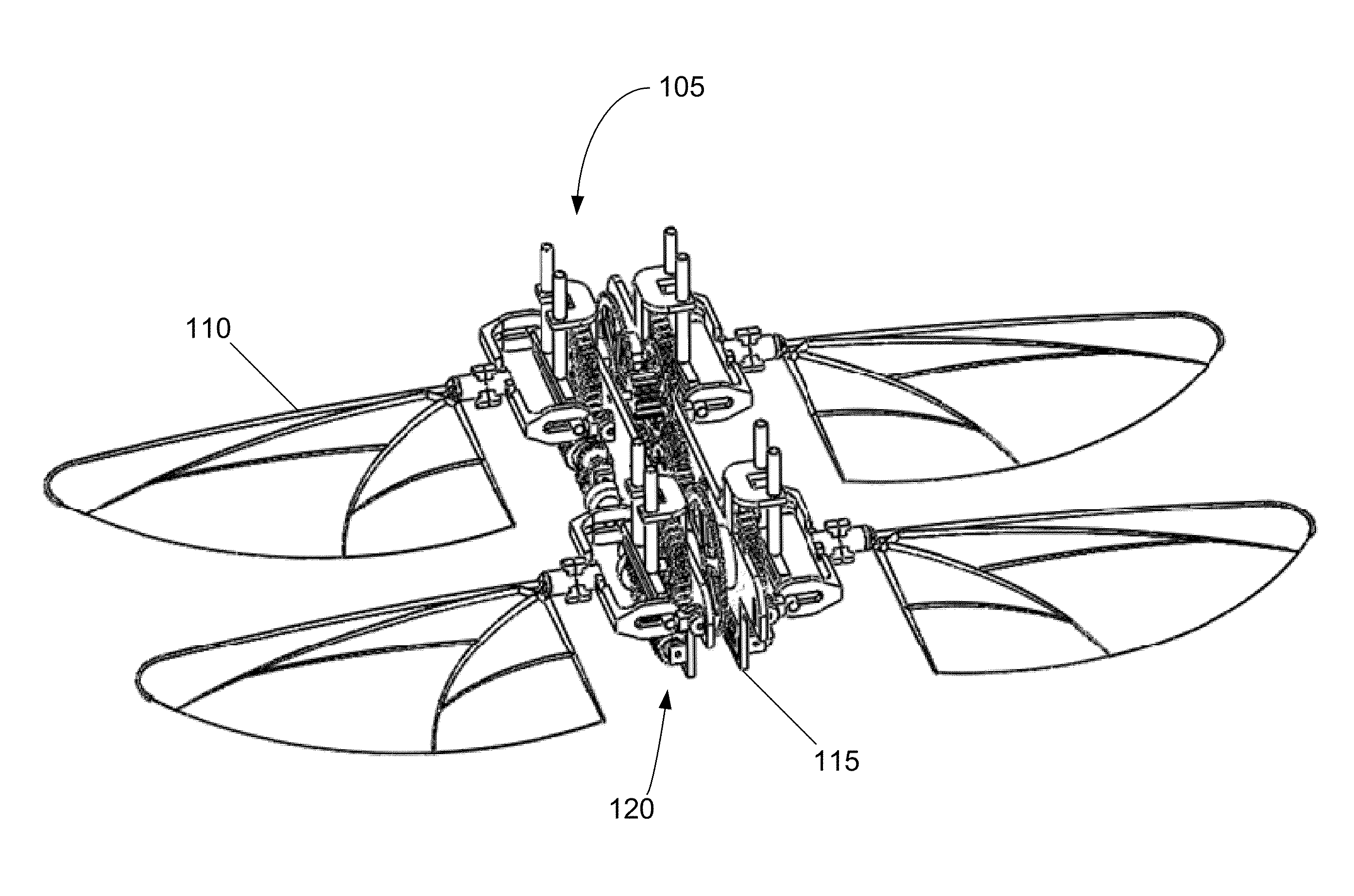Hovering and gliding multi-wing flapping micro aerial vehicle
a multi-wing, micro-aerial technology, applied in the field of aerial vehicles, can solve the problems of fixed-wing mavs not being able to hover or fly backwards, affecting the range, endurance, operation altitude, etc., and reducing the amplitude of the flapping. , the effect of increasing the amplitude of the flapping actuator
- Summary
- Abstract
- Description
- Claims
- Application Information
AI Technical Summary
Benefits of technology
Problems solved by technology
Method used
Image
Examples
example 1
[0243]To test the under actuated system step response in simulation, an initial condition of φRef=−12°, θRef=11°, ψRef=11.5° is set and the MAV is commanded to maintain a 20 cm altitude. Initially, the system was tested with a manually selected constant PID gains. The results are shown in the FIGS. 34a-34e. The five graphs show pitch, roll, yaw, altitude and actuator thrust response versus time, respectively. As shown, settling time for manual selection was approximately 50-60 seconds, with an overshoot of approximately 4 degrees. As shown, due to the complexities in the system, manual gain control is less than ideal and requires extensive experimentation to set useful values.
[0244]In some embodiments, feedback type controllers can be used for improved performance. A Proportional-Integral-Derivative (“PID”) controller, for example, can be used. The three components of the PID controller can be tuned to optimize response time, overshoot, or a combination thereof. As discussed below, ...
example 2
[0248]To measure the effectiveness of the system 3500, the cost function for the GA 3510 can be defined as the cumulative area under the step response graph until the system 3500 settles to the commanded, or desired, value. In other words, the smaller the area under the curve, the faster the response time of the system 3500. Generally, to apply the GA 3510 to a selection problem, the gene structure and evaluation method should be prepared. In this case, for example, the set of PI gains 3520 can be defined as a gene and the fitness function can be defined as the cost metric. The crossover rates and the mutation rates are set as 100% and 10%, respectively. The cost function is the area sum under the response curves.
[0249]As shown in the Table 2 below and in FIGS. 36a-36c, there is a marked performance improvement using the GA based design tuning 3500 over manual gain selection 2900. The table highlights the results of gain tuning using the devised GA 3510 after 6 generations. As menti...
example 3
[0251]In some embodiments, a PD controller can be used. By removing the integral component, faster response times are possible, but some accuracy is sacrificed. Thus, while the system tends to settle to the reference position, in some cases it is slightly off. As with all control systems, accuracy, speed, and processor power can be balanced, as required, to meet, for example and not limitation, specific mission, cost, or design parameters.
[0252]In this example, the system was provided an initial set of gains and an initial deflection of 20-30 degrees with a reference position of zero degrees. As shown in FIGS. 36d and 36e, the output response is much faster than predicted in the simulation model for the PID controller or the PD Controller. As shown, response time for both pitch and roll is 1-1.5 seconds. Of course, these response times are significantly affected by several factors, including but not limited to, under or over actuation, vehicle and / or payload weight, wing span and sh...
PUM
 Login to View More
Login to View More Abstract
Description
Claims
Application Information
 Login to View More
Login to View More - R&D
- Intellectual Property
- Life Sciences
- Materials
- Tech Scout
- Unparalleled Data Quality
- Higher Quality Content
- 60% Fewer Hallucinations
Browse by: Latest US Patents, China's latest patents, Technical Efficacy Thesaurus, Application Domain, Technology Topic, Popular Technical Reports.
© 2025 PatSnap. All rights reserved.Legal|Privacy policy|Modern Slavery Act Transparency Statement|Sitemap|About US| Contact US: help@patsnap.com



